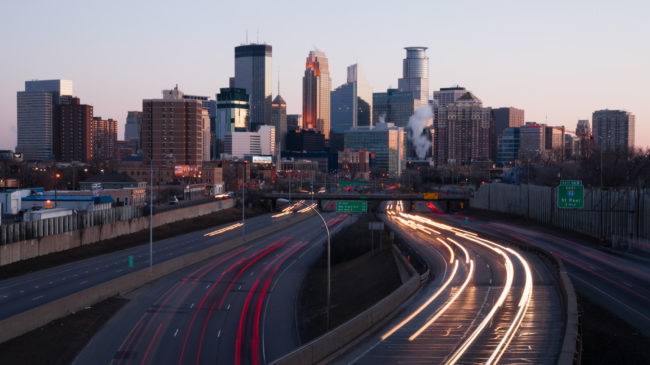A recent op-ed in The New York Times headlined, “Stop Building More Roads,” University of Toronto Professor Shoshanna Saxe and Kristen MacAskill, a professor at the University of Cambridge, wrote that road construction is “environmentally destructive, and it promotes urban sprawl, congestion, air pollution, and inequality.” Instead of more highway investment, they argued for more busways, urban pedestrian lanes, and high-speed rail megaprojects.
Saxe and MacAskill argue that a mature country like the United States already has an ample highway system, and it just needs regular maintenance. Yet as civil engineers, they should know that highways and bridges have finite useful lives. When they near the end of those lives, simply applying yet another new asphalt layer yields diminishing returns. At that point, highways need to be rebuilt from the foundation up, and bridges need either major rehabilitation or replacement. Their piece ignores this reality.
These points apply in full measure to the U.S. Interstate Highway System, the backbone of personal and commercial travel. With a mere 2.6 percent of America’s total lane-miles, the Interstates handle 26 percent of U.S. vehicle miles of travel. And much of that system, begun in 1956, has reached the need for replacement.
That is not just my judgment. In 2015, Congress asked the National Academy of Sciences (NAS) to assess the future of the Interstates. The December 2018 NAS report came as a shock to most people. NAS’s expert committee found that, despite a few states having rebuilt some corridors and replacing several major bridges, overall the Interstates are wearing out and most need to be rebuilt from the foundation up.
“The Interstates have long been the backbone of our country’s transportation system, but most of them have exceeded their design lives and in many places are worn and overused,” the expert panel’s chairman Norm Augustine said.
Many key corridors—especially those with high and growing truck traffic—need additional lanes. And between 50 and 100 urban interchanges are of obsolete 1950s design and have become major bottlenecks for trucks and commuters. The estimated cost of a bare-bones fix—not adding any new routes, just reconstructing and selectively widening what is already there—is $1 trillion over the next 20 years.
A new report just out from The Road Information Project (TRIP) is a useful follow-up to the 2018 NAS report. Based on federal highway data, it found:
- 11 percent of Interstate pavements are in poor or mediocre condition;
- 27 percent of Interstate bridges need repair or replacement;
- 54 percent of Interstate bridges are at least 50 years old; and,
- 47 percent of urban Interstate miles are seriously congested during rush hours.
Saxe and MacAskill seem to suggest that focusing on Interstate concerns like these is “outdated.” But their imagined future of transit and high-speed rail instead of better highways is questionable.
First, there is the enormous taxpayer cost. All but three of the world’s individual high-speed rail lines have required massive taxpayer subsidies for construction costs, and most also need subsidies for their operating costs. Major highways like the Interstates are largely user-funded, via either fuel taxes or tolls.
Second, when the country reaches a post-COVID-19 phase, transportation will be different in several ways. Fewer people are likely to use mass modes of travel (transit and passenger trains) in future years. And the ability of an automated vehicle to travel safely while the occupants do other things will likely increase the attractiveness of driving compared with the alternatives in the coming years.
As for freight, the green dream of shifting freight shipping from truck to rail is fanciful. Heavy truck travel on the Interstates increased by 45 percent between 2000 and 2018. Today’s slimmed-down freight railroads specialize in unit trains of things like grain, fuel, and containers. Long-distance trucking handles everything, and the flexibility of trucks means the same vehicle that makes the long-distance trip can deliver its load right to the distribution center, which railroads cannot do.
Our growing economy needs a modernized Interstate Highway System. But this need not require a massive investment of federal tax dollars. A detailed Reason Foundation policy study analyzed the cost of modernizing each state’s Interstate highways and came up with a figure close to the NAS study’s 2018 estimate: about $1 trillion over the next 20 years.
The Reason study also explored ways of paying for this huge set of projects. Rather than a massive increase in federal fuel taxes, the alternative is to finance these state-led projects via long-term toll revenue bonds. The tolling system would be all-electronic, with no need for toll booths or toll plazas, and tolls would be indexed to inflation. The analysis found that toll-financing would cover the capital and operating costs of the modernized Interstates in all but five states.
“More roads” does not necessarily mean new routes—though there is a case for selective additions to the Interstate system, as the NAS committee also found. But the main need is for massive investment to rebuild and modernize the Interstates we already have. We must not let pipedreams get in the way of addressing this critically important need.

